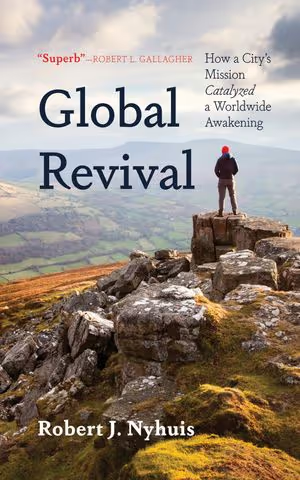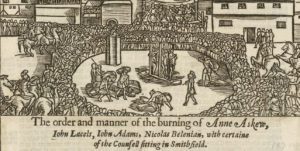Robert Nyhuis’ Global Revival: How a City’s Mission Catalysed a Worldwide Awakening is an excellent contribution to the history of the Australian church. His enthusiasm for ministry as the Victorian and Tasmanian State Executive Officer and Australia National Chair of the Churches of Christ shines through in this volume.
Outlining the Moment
As I have written about before, the 1902 Melbourne Simultaneous Mission is a landmark event in the history of Australian evangelicalism, the apex of united evangelistic activity in the late-colonial/early-federation era, and the largest series of evangelistic events in Australia before the Billy Graham Crusade of 1959. Half the population of Melbourne at that time attended the two weeks of mission events (250,000 people) and over eight thousand conversions were recorded. The Mission was the beginning of a year-long around-the-world evangelistic campaign for Dr. Reuben A. Torrey, superintendent of the Moody Bible Institute and pastor of Chicago Avenue Church. Historian Geoffrey Treloar has suggested that Torrey might be “the first global revivalist” .[1] The participants in and widely circulated accounts of the Melbourne Simultaneous Mission helped to contribute to and inspire new waves of evangelistic activity, including the 1904–5 Welsh Revival and evangelistic movements in India, South America and Korea. Torrey’s ministry also contributed to the emergence of Pentecostalism in the early twentieth century.[2]

Global Revival: How a City's Mission Catalyzed a Worldwide Awakening
Robert Nyhuis
Purchase from AmazonGlobal Revival: How a City's Mission Catalyzed a Worldwide Awakening
Robert Nyhuis
In 1902, one of history’s most statistically significant revivals was led by three American evangelists, R. A. Torrey, Charles Alexander, and W. E. Geil. It quickly spread internationally after beginning in Melbourne, Australia, where a staggering 8,642 conversions were recorded in just four weeks. This largely untold story chronicles the beginning of the twentieth century’s “great awakening” better known for its later impact in Wales and at Azusa Street, Los Angeles.
A Valuable and Readable Chronicle
The writing and publishing of Australian church history, especially the history of evangelicalism, is still very much a work in progress. Nyhuis has done Australian Christianity a great service in writing a thoroughly researched and referenced account of this mission, its background, and its global impact. Many extended quotations from primary sources and eighteen illustrations spread throughout give a fuller sense of the cultural context, individual personalities involved, and firsthand experience of the mission events themselves .[3]
The bulk of the book is a spiritually warm historical account, rather than a critical history. Little space is given to analysis of sources, alternative explanations, or diverse causal factors. There is a strong focus on the newly amalgamated Methodist denomination, which is understandable given its spiritual vibrancy and rapid growth at this time and Methodists’ dominant participation in, attendance at, and influence on the mission.[4] Sadly, however, the contribution and perspective of the many participating Presbyterian and Church of England ministers and churches gets comparatively little attention. There are some noticeable omissions on this count. Influential evangelist John MacNeil is simply introduced as a “Melbourne minister” (pp. 19–20) with no mention of the fact that he was employed as an evangelist by the Presbyterian Church of Victoria. Extremely influential Presbyterian elder and churchman James Balfour is only referenced as a “Christian politician” (p. 20). The Church of England’s evangelistic efforts, such as their 1888 simultaneous mission, are also not significantly commented upon.[5]
Revival
Where Nyhuis does engage in critical history and practical application for ministry today, the results are underwhelming. Global Revival begins with an overview of theological and historical literature on revival (chapter 1). Sadly, this survey lacks rigour as both history and theology. He fails to clearly distinguish between the two in the flow of the chapter.[6]
In the opening and closing chapters, Nyhuis provides criteria for whether the 1902 Melbourne Simultaneous Mission can be described as a revival:
United and energizing preparation and prayer, a transformative intentional message by prominent missioners, significant evangelistic fruitfulness, and broader social impact. These hallmarks of revival were uniquely outworked in a particular season of opportunity in Melbourne in 1902 (p. 11).
Particularly significant for his argument in chapter 7 is the case made by Stuart Piggin and Robert Linder in their Attending to the National Soul. In this volume they argue that the 1959 Billy Graham Crusade should be considered a revival (albeit not “the harbinger of a brilliant new period”[7]). The analogy is strong, and so by Piggin and Linder’s standard, the 1902 Mission can be legitimately called a revival.
The comparison between those two revivals dispiritingly echoes the evangelistic challenges in the contemporary West and warns us against over-glamorising the so-called halcyon days of revival. Both the 1902 Simultaneous Mission and the 1959 Billy Graham Crusade led, overall, to modest, short-term church membership growth [8]. Any discernible positive social impacts were only short-lived.[9] The 1902 Mission fell far short especially when measured against the ambitious prayers and predictions of Torrey and others. The substantial long-term (if theologically mixed) legacy of the 1902 Mission on world Christianity is, however, the most impressive outcome.
Learning from History
Nyhuis writes as a zealous ministry leader, inspired by past evangelistic glories and motivated to provide principles that will guide faithful and effective ministry in twenty-first century Australia. While I share the same inspiration and motivation, I think the provided principles are flawed.
It is common for popular studies of revival to look for repeated preparatory features and encourage a conscientious effort to replicate those features in the prayerful expectation that God might use them to bring about a contemporary revival.[10] Nyhuis fits in this tradition. He identifies four revival characteristics (united prayer and preparation, a message focussed on transformation, evangelistic fruitfulness, and community impact and church revitalization) and describes their manifestation in the 1902 Melbourne Simultaneous Mission. He then encourages his readers to strive to emulate them:
For these four ‘revival’ features to be replicated today [there] needs [to be] more than us merely awaiting sovereign favour. Intentional leadership, planning, and prayerfulness are significant investments into desired outcomes (p. 118).
None of Nyhuis’s characteristics are objectionable. But it is one thing to pursue richer inter-denominational unity because it is godly, or because wisdom suggests it will help an evangelistic initiative be effective. It is another to expect that the unity itself will be a spiritual precondition to a higher order of fruitfulness. This shift of reasoning is theologically and historically questionable. The same kind of thinking attributes a special spiritual force not to prayer as such, but to a particular kind of prayer: a concerted kind of prayer, in prayer meetings, ideally inter-denominational. Prayer meetings are good, but they are not distinctly and especially game-changing means of grace.
The study questions at the end of each chapter stimulate the reader to adopt this methodology, with questions that sometimes encourage speculation and application that the chapters do not equip the reader to be able to entertain. For example:
What might have happened if John Virgo had insisted on running the Mission choir … Did this sort of attitude matter in 1902, and would it matter today? (p. 43)
This kind of historical logic could even, without discernment, roam beyond Nyhuis’s four characteristics to identify and encourage yet other practices and values as potential preconditions for revival, producing much more concerning distortions in church life. One could, for example, make Torrey’s teaching on Spirit baptism vital to a transformative message that stirs revival.
As a critical history or a guide for contemporary evangelism, the book is lacking. But as a historical chronicle of an extraordinary time in Australian evangelical history it is very valuable. Global Revival is accessible, passionate and brief, which I hope will motivate even more people to read it all the way through. Given the significance of these events for the history of Australian evangelicalism (and beyond), we ought to be more familiar with them. It is both encouraging and enlightening to know how God has worked in our nation in the past. Nyhuis’s work thus deserves a wide readership.
[1] The mission was also incorporated into the international travels of the unordained evangelist William Edgar Geil. The third major American leader of the Mission was Charles M. Alexander who led the music. Alexander returned to Australia for simultaneous missions together with evangelist J. Wilbur Chapman in 1909 and 1912.
[2] Nyhuis references F. Dale Bruners’ 1970 claim that Torrey was “a kind of John the Baptist figure for later Pentecostalism” (113).
[3] Three of the appendices provide even more historical specificity: five printed sermons (appendix 2), a description a personal gospel-presentation method advocated by one of the main evangelists, William Edgar Geil (appendix 3); and a letter of condolence to Hannah MacNeil the widow of influential Victorian evangelist John MacNeil, who died in 1896 (appendix 4).
[4] “The contribution of the Wesleyan Methodists to the evangelization of Melbourne in the nineteenth century was a substantial factor in shaping a revivalist climate of revitalizing fervour that led to Torrey’s later visit to the city” (13). Various Methodist initiatives are outlined on pages 13–16 and their astonishing growth during this period on pages 105–8.
[5] For a study of Anglican evangelicalism in Victoria see Wei-Han Kuan’s excellent book.
[6] For example, Nyhuis to quote from Martyn Lloyd-Jones’s Joy Unspeakable multiple times early in the chapter (6). This idiosyncratic devotional-theological book is hardly a historical or theological authority. Or again, descriptive passage from Geoffrey Treloar is used to make an evaluative theological point (7).
[7] S. Piggin and R. D. Linder, Attending to the National Soul: Evangelical Christians in Australian History 1914–2014 (Clayton: Monash University Publishing, 2020), 289.
[8] Although while Nyhuis notes a drop in membership in the Presbyteries of Melbourne in 1903, in the following years the Presbyterian Church of Victoria’s Statistics Committee actually reported growth beyond the 1902 figures.
[9] Nyhuis speculates whether more sustained revivalistic activity might have secured more lasting change (103). The evidence of the 1909 and 1912 Chapman–Alexander missions point in the opposite direction: to a saturation point and declining impact for such efforts.
[10] Indeed, the sharing of stories of revival is itself a preparatory feature that popular historians often don’t identify as such.
















